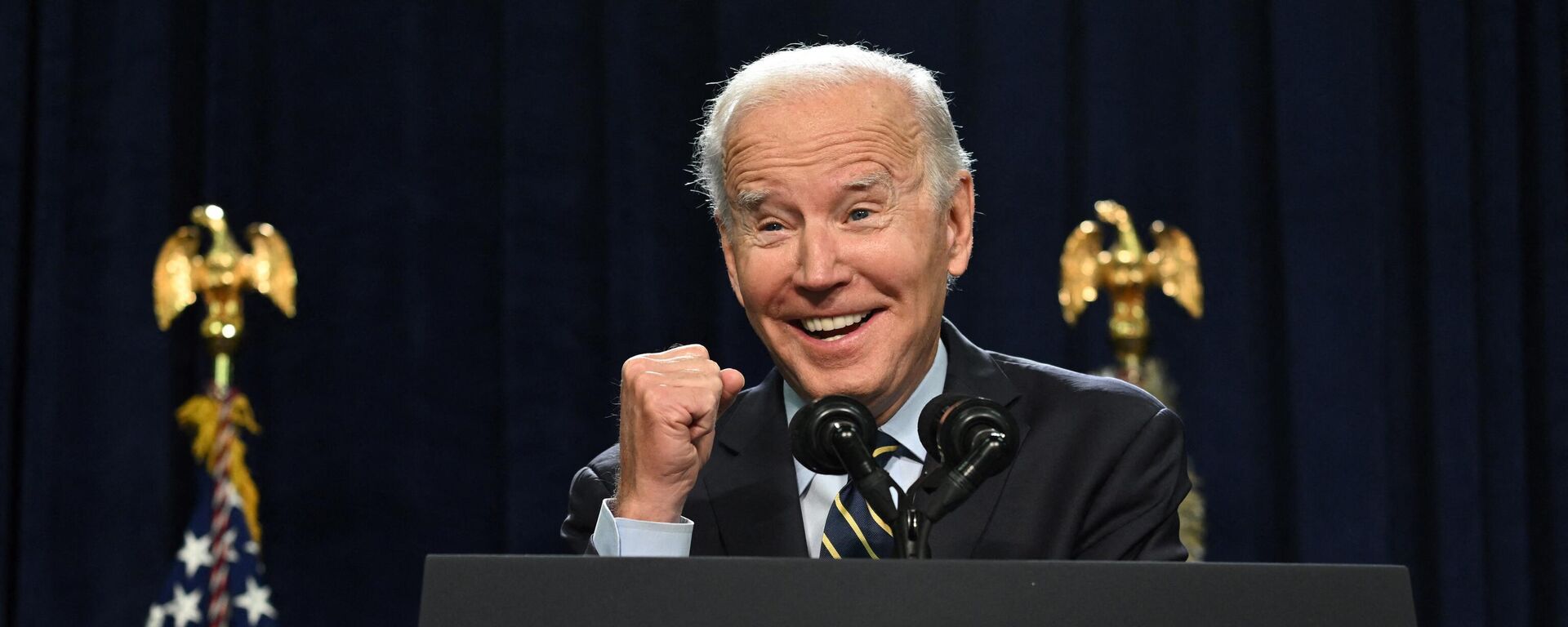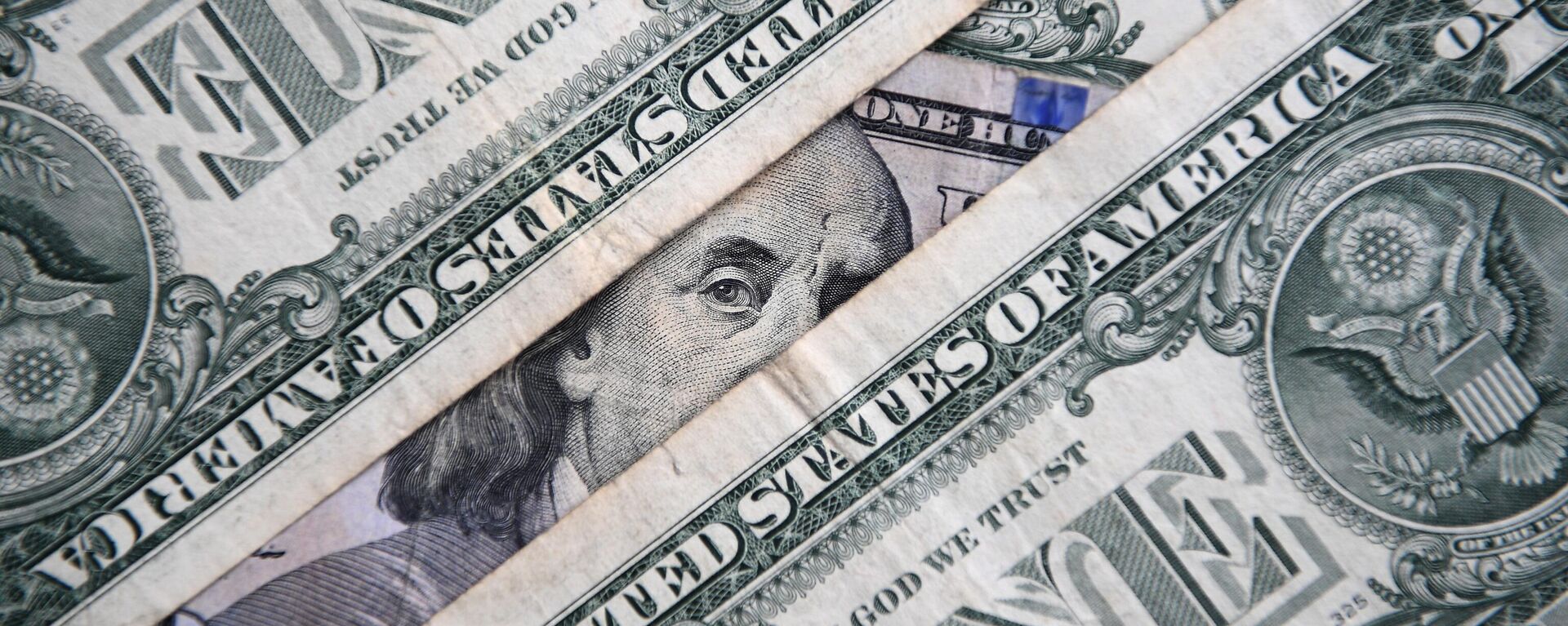https://sputnikglobe.com/20230506/us-national-debt-so-vast-it-could-implode-world-economy-heres-why-1110144915.html
US National Debt So Vast It Could Implode World Economy: Here's Why
US National Debt So Vast It Could Implode World Economy: Here's Why
Sputnik International
The spectacle in Washington over the debt ceiling (i.e. restrictions on how much the government is allowed to borrow), has pushed the White House to claim America’s adversaries are rubbing their hands in anticipation of a US default. But in a globalized world, the US defaulting on its obligations threatens to take the rest of the planet with it.
2023-05-06T16:03+0000
2023-05-06T16:03+0000
2023-05-06T16:59+0000
economy
joe biden
kevin mccarthy
mitch mcconnell
china
washington
russia
gop
republicans
senate
https://cdn1.img.sputnikglobe.com/img/07e7/05/06/1110144717_0:160:3072:1888_1920x0_80_0_0_e9eec23ed3130de35ca9f5306618dfd7.jpg
President Biden has launched a charm offensive aimed at Congressional Republicans amid the debt ceiling crunch, hailing GOP House leader Kevin McCarthy as an “honest man” while patting himself on the back as a leader with “a hell of a lot of wisdom” and as someone who “know[s] more than the vast majority of people.”Senate Minority Leader Mitch McConnell signaled to the White House that he’s ready to play hard ball, signing a letter together with over 40 of his GOP colleagues addressed to Democratic Senate Majority Leader Chuck Schumer warning that Republicans would not support “any bill that raises the debt ceiling without substantive spending and budget reforms.”McConnell and McCarthy want deep cuts – including trillions in spending gone from the budget over the next decade on a range of programs, including hundreds of billions from Biden’s lavish climate agenda.The US federal government is projected to run out of money and default on its debt as soon as June 1, with Treasury Secretary Janet Yellen urging lawmakers to get their act together before plunging the country into economic turmoil.Biden has taken aim at the GOP and MAGA Republicans in particular over the debt ceiling deadlock, accusing them of pushing a “manufactured crisis” and throwing shade on his good jobs statistics. “Let’s get it straight: They’re trying to hold the debt hostage for us to agree to some draconian cuts, magnificently difficult and damaging cuts. But unfortunately, they’re threatening to undo all this progress by letting us default,” he said Friday.America’s budget deficit ballooned by more than $1.1 trillion in the first half of fiscal year 2023, $430 billion above what it was during the same period in 2022. The US hasn’t run a budget surplus since 2001. The failure to match revenue and spending has led to a ballooning of the national debt, from about $3 trillion in 1989 to over $31.7 trillion today – with the debt jumping by about $15 trillion in the past decade alone. Total debt – which includes the national debt plus state, local and individual obligations, has surpassed $96 trillion – less than 10 trillion shy of the world’s entire gross domestic product of $103.8 trillion in 2022.US Economic Collapse: World Would Reap What America SowsThe Biden administration has sought to distract Americans from the gargantuan debt bubble caused by decades of spendthrift government policy by using the "R"-word. On Thursday, White House Office of Management and Budget Director Shalanda Young told reporters that she agrees wholeheartedly with Director of National Intelligence chief Avril Haines’ assessment that Russia and China would love for the US to default and throw the economy into chaos.But the real “test” may be just how well the rest of the world will be able to manage the fallout of a US debt crisis and financial collapse.In 1929, a market crash on Wall Street triggered a global depression that affected most of the planet and ultimately culminated in the Second World War. Eighty years later, another US market crash triggered a global "Great Recession," shaving trillions off US and global economic growth and depriving an entire generation of young people entering the workforce of decent jobs – with many workers, both young and old, subsequently dropping out of the labor market.China, Russia, and other BRICS economies have done their best to prepare for another US economic collapse, ramping up economic cooperation, forging new banking agreements, and making efforts to reduce dependents on the petrodollar, US technology, and escape the control of US-controlled financial institutions.But this process remains incomplete. As some observers have pointed out, a US default would be “devastating” for global markets, undermining faith in the US financial system - the second largest in the world after China by total banking sector assets, and potentially triggering a domino effect.While the US’ global share of world economic output has dropped from 32 percent in 1980 to 24 percent in 2020, and its share of global trade fell from 14 to 11 percent over the same period, the dollar remains the go-to instrument of international exchange, accounting for about 59 percent of foreign central banks’ holdings, and 74 to 96 percent of all trade in the world, depending on region.Unsustainable ModelWashington’s spendthrift economic policy and debt-accumulating policy threatens both the United States and the rest of the world, but with no political accountability, there’s no easy solution to the problem.“Even if Congress manages to raise the debt ceiling before anything so dire happens, its flirtation with disaster serves as a warning about the deterioration of America’s fiscal health and the difficulty of recovering it,” one European business publication pointed out.The nub of the issue, according to former Congressional Budget Office chief Doug Elmendorf, is that neither of the major parties are willing to sacrifice popular support to make painful, but necessary reforms that could resolve the debt issue – with Republicans averse to cutting entitlements, while Democrats avoid raising taxes.“The core measure of vulnerability is not, in the first instance, America’s debt level but rather its ballooning fiscal deficit,” British business media noted. Pointing to projections of the budget deficit averaging 7-8 percent over the next decade, the outlet pointed out that back-to-back-to-back deficits years on end will result in the national debt ballooning up to 250 percent of GDP by 2050 (it’s already 123 percent now).Free Accounting AdviceAnother factor, not accounted for by most US officials and economists, but undoubtedly playing a key role in America’s debt crisis, is Washington’s foreign policy – with the military-industrial complex, which consumes over 12 percent of federal spending and nearly half of discretionary spending, kicked into overdrive over the past two decades of empire-building in Europe, Afghanistan, and the Middle East. It’s no big mystery why the Clinton administration was able to run modest budget surpluses of 0.8-1.2 percent between 1998 and 2001, given that the end of the Cold War in 1991 allowed the nation to enjoy an unprecedented “peace dividend” stemming from the lack of the need to pamper the MIC and fund costly military adventurism abroad.Unfortunately, the current administration seems unlikely to turn to non-interventionism to run down the debt and deficit. Instead, it seems to be bent on simultaneously fueling conflicts with adversaries ranging from Russia and China to Iran and North Korea – with all of these crisis centers requiring money – and a lot of it.The biggest danger facing the planet may very well be that an America facing economic crisis could turn to the use of its vast military machine to even more directly exploit dependents and clients to obtain critical resources or markets, or engage in military policing operations to prevent nations from switching sides and joining adversarial emerging economic or political blocs.
https://sputnikglobe.com/20230506/what-is-14th-amendment-biden-not-ready-to-invoke--how-is-it-tied-to-us-debt-ceiling-crisis-1110141414.html
https://sputnikglobe.com/20230505/biden-warns-gop-that-defaulting-on-us-debt-will-end-string-of-good-jobs-reports-1110131337.html
https://sputnikglobe.com/20230418/us-losing-ground-to-china-and-russia-as-arab-oil-giants-bet-on-brics--1109631093.html
https://sputnikglobe.com/20230504/debt-ceiling-battle-and-federal-reserve-interest-hikes-could-wreck-us-economy-1110096898.html
https://sputnikglobe.com/20230502/a-us-default-would-cause-systemic-financial-crisis-destabilize-global-economy-1110038307.html
china
washington
russia
Sputnik International
feedback@sputniknews.com
+74956456601
MIA „Rossiya Segodnya“
2023
News
en_EN
Sputnik International
feedback@sputniknews.com
+74956456601
MIA „Rossiya Segodnya“
Sputnik International
feedback@sputniknews.com
+74956456601
MIA „Rossiya Segodnya“
us debt, debt crisis, debt, budget deficit, budget, joe biden, united states, russia, china, world economy, economy
us debt, debt crisis, debt, budget deficit, budget, joe biden, united states, russia, china, world economy, economy
US National Debt So Vast It Could Implode World Economy: Here's Why
16:03 GMT 06.05.2023 (Updated: 16:59 GMT 06.05.2023) The spectacle in Washington over the debt ceiling (i.e. restrictions on how much the government is allowed to borrow), has pushed the White House to claim America’s adversaries are rubbing their hands in anticipation of a US default. But in a globalized world, the US defaulting on its obligations threatens to take the rest of the planet with it.
President Biden has launched a charm offensive aimed at Congressional Republicans amid the debt ceiling crunch, hailing GOP House leader Kevin McCarthy as an “honest man” while
patting himself on the back as a leader with “a hell of a lot of wisdom” and as someone who “know[s] more than the vast majority of people.”
Senate Minority Leader Mitch McConnell
signaled to the White House that he’s ready to play hard ball, signing a letter together with over 40 of his GOP colleagues addressed to Democratic Senate Majority Leader Chuck Schumer warning that Republicans would not support “any bill that raises the debt ceiling without substantive spending and budget reforms.”
McConnell and McCarthy want deep cuts – including trillions in spending gone from the budget over the next decade on a range of programs, including hundreds of billions from Biden’s lavish climate agenda.
The US federal government is projected to run out of money and default on its debt as soon as June 1, with Treasury Secretary Janet Yellen urging lawmakers to get their act together before plunging the country into economic turmoil.
Biden has taken aim at the GOP and MAGA Republicans in particular over the debt ceiling deadlock,
accusing them of pushing a “manufactured crisis” and throwing shade on his good jobs statistics. “Let’s get it straight: They’re trying to hold the debt hostage for us to agree to some draconian cuts, magnificently difficult and damaging cuts. But unfortunately, they’re threatening to undo all this progress by letting us default,” he said Friday.
America’s budget deficit ballooned by more than $1.1 trillion in the first half of fiscal year 2023, $430 billion above what it was during the same period in 2022. The US hasn’t run a budget surplus since 2001. The failure to match revenue and spending has led to a ballooning of the national debt, from about $3 trillion in 1989 to over $31.7 trillion today – with the debt jumping by about $15 trillion in the past decade alone. Total debt – which includes the national debt plus state, local and individual obligations, has surpassed
$96 trillion – less than 10 trillion shy of the world’s entire gross domestic product of $103.8 trillion in 2022.
US Economic Collapse: World Would Reap What America Sows
The Biden administration has sought to distract Americans from the gargantuan debt bubble caused by decades of spendthrift government policy by using the "R"-word. On Thursday, White House Office of Management and Budget Director Shalanda Young
told reporters that she agrees wholeheartedly with Director of National Intelligence chief Avril Haines’ assessment that Russia and China would love for the US to default and throw the economy into chaos.
“This – this is – this just gives to our global competitor. They love this. They love to see chaos in the American system. They love to see that we can’t do our basic jobs. It’s no less than a test of what works in this world. Does democracy still work or does the Chinese way work?” the official asked.
But the real “test” may be just how well the rest of the world will be able to manage the fallout of a US debt crisis and financial collapse.
In 1929, a market crash on Wall Street triggered a global depression that affected most of the planet and ultimately culminated in the Second World War. Eighty years later, another US market crash triggered a global "Great Recession,"
shaving trillions off US and global economic growth and depriving an entire generation of young people entering the workforce of decent jobs – with many workers, both young and old, subsequently
dropping out of the labor market.
China, Russia, and other BRICS economies have done their best to prepare for another US economic collapse, ramping up economic cooperation, forging new banking agreements, and making efforts to reduce dependents on the petrodollar, US technology, and escape the control of US-controlled financial institutions.
But this process remains incomplete. As some observers have pointed out, a US default would be “devastating” for global markets, undermining faith in the US financial system - the
second largest in the world after China by total banking sector assets, and potentially triggering a domino effect.
The contagion of a steep US economic decline would to quickly spread to the economies of America’s allies and client states, as well as major trade partners in Asia and the Middle East – some of which are seeking independence from Washington, but continue to rely on its massive economy (US-China trade reached over $690 billion in 2022 despite tensions, for example), and the dollar.
While the US’ global share of world economic output has
dropped from 32 percent in 1980 to 24 percent in 2020, and its share of global trade fell from 14 to 11 percent over the same period, the dollar remains the go-to instrument of international exchange, accounting for about
59 percent of foreign central banks’ holdings, and 74 to 96 percent of all trade in the world, depending on region.
Washington’s spendthrift economic policy and debt-accumulating policy threatens both the United States and the rest of the world, but with no political accountability, there’s no easy solution to the problem.
“Even if Congress manages to raise the debt ceiling before anything so dire happens, its flirtation with disaster serves as a warning about the deterioration of America’s fiscal health and the difficulty of recovering it,” one European business publication
pointed out.
The nub of the issue, according to former Congressional Budget Office chief Doug Elmendorf, is that neither of the major parties are willing to sacrifice popular support to make painful, but necessary reforms that could resolve the debt issue – with Republicans averse to cutting entitlements, while Democrats avoid raising taxes.
“Both those positions are obviously politically popular, but they take off the table the biggest pieces of the federal budget. So it’s increasingly hard for either party to develop a plan that puts fiscal policy on a sustainable path, much less agree on a set of policies,” Elmendorf said.
“The core measure of vulnerability is not, in the first instance, America’s debt level but rather its ballooning fiscal deficit,” British business media
noted. Pointing to projections of the budget deficit averaging 7-8 percent over the next decade, the outlet pointed out that back-to-back-to-back deficits years on end will result in the national debt ballooning up to 250 percent of GDP by 2050 (it’s already 123 percent now).
Another factor, not accounted for by most US officials and economists, but undoubtedly playing a key role in America’s debt crisis, is Washington’s foreign policy – with the military-industrial complex, which consumes over 12 percent of federal spending and nearly half of discretionary spending, kicked into overdrive over the past two decades of empire-building in Europe, Afghanistan, and the Middle East. It’s no big mystery why the Clinton administration was able to run modest budget surpluses of 0.8-1.2 percent between 1998 and 2001, given that the end of the Cold War in 1991 allowed the nation to enjoy an
unprecedented “peace dividend” stemming from the lack of the need to pamper the MIC and fund costly military adventurism abroad.
Unfortunately, the current administration seems unlikely to turn to non-interventionism to run down the debt and deficit. Instead, it seems to be bent on simultaneously fueling conflicts with adversaries ranging from Russia and China to Iran and North Korea – with all of these crisis centers requiring money –
and a lot of it.The biggest danger facing the planet may very well be that an America facing economic crisis could turn to the use of its vast military machine to even more directly exploit dependents and clients to obtain critical resources or markets, or engage in military policing operations to prevent nations from switching sides and joining adversarial emerging economic or political blocs.







